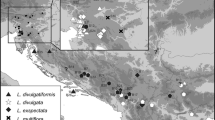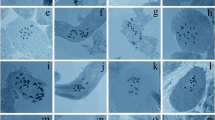Abstract
Although the Dendranthema zawadskii complex has been known to comprise a series of polyploids (4×, 6×, 8×), we found diploid individuals (with 2n=18) to occur in four populations of D. zawadskii var. latilobum in the southern region of Korea. Karyotypes of metaphase chromosomes were diverse because numbers of metacentric, submetacentric, and acrocentric chromosomes differ even within a population. A total of 17 karyotypes were found in 31 diploid individuals collected from the four populations. The karyotypes were also diverse in the presence or absence of chromosomes with a secondary constriction on a short or long arm and, if present, in the number of such chromosomes. They were further diverse in the presence or absence of non-homologous chromosome(s), the presence or absence of a chromosome with a satellite, and, if present, how many and where satellites are present. Almost the same pattern of diversity was found in diploid individuals (with 2n=18) of D. boreale and D. indicum as well, irrespective of whether they occur together with D. zawadskii var. latilobum or not. Structural features of chromosomes in the variously different karyotypes suggest that reciprocal translocation and the hybridization between individuals with different karyotypes had repeatedly occurred not only in D. zawadskii var. latilobum, but also in D. boreale and D. indicum. Morphologically intermediate individuals between D. zawadskii var. latilobum and D. indicum suggests that the hybridization occur with different species as well.





Similar content being viewed by others
Reference
Bremer K (1994) Asteraceae, cladistics and classification. Timber Press, Portland, pp 435–478
Bremer K, Humphries C (1993) Genetic monograph of the Asteraceae-Anthemideae. Bull Nat Hist Mus Bot Ser 23:73–177
Dowrick GJ (1952) The chromosome of Chrysanthemum 1. Heredity 6:365–375
Du B, Lin Q, Zhu C, Ke S (1989) Karyotype studies of two species on Dendranthema (in Chinese). J Wuhan Bot Res 7: 293–296
Hotta M, Yamagawa N, Hirai Y, Shiuchi T (1996) Taxonomical notes on plants of southern Japan III. Distribution and taxonomy of the Dendranthema ornatum group around southern Kyushu (in Japanese with English abstract). Acta Phytotax Geobot 47:91–104
Khaung KK, Kondo K, Tanaka R, Nakata M (1995) A comparison of fluorescent banding patterns in Dendranthema indicum collected in Japan and China. La Kromosomo II 79–80:2746–2753
Kitamura S (1940) Compositae Japonicae. Mem Coll Sci, Kyoto Emper Univ, Ser B 15:316–375
Kitamura S (1948) Kiku (in Japanese). Heibonsha, Tokyo, pp 1–176
Kitamura S (1978) Dendranthema et Nipponanthemum. Acta Phytotax Geobot 24:165–170
Komarov VL (1961) Flora URSS, vol 26. Editio academiae scientiarum, Mocqua, pp 364–388
Kondo K, Khaung KK, Tanaka R, Nakata M (1995) Fluorescent banding patterns in hexaploid Dendranthema occidentali-japonense and D. vestitum. La Kromosomo II 79–80:2739–2745
Koyama H (1995) Asteraceae (Compositae). In: Iwatsuki K, Yamazaki T, Boufford DE, Ohba H (eds) Flora of Japan, vol IIIB, Angiospermae, Dicotyledoneae, Sympetalae (b). Kodansha, Tokyo, pp 77–96
Lee YN (1967a) A cytotaxonomic study on Chrysanthemum zawadskii Herbich in Korea, 1. natural hybridization. Korean J Bot 10:31–35
Lee YN (1967b) Chromosome numbers of flowering plant in Korea. J Korean Cult Res Inst 11:455–478
Lee YN (1969) A cytotaxonomic study on Chrysanthemum zawadskii Herbich in Korea, 2. polyploidy. Korean J Bot 12:35–48
Lee YN (1975) Taxonomic study on white flowered wild Chrysanthemum in Asia. Korean J Bot 14:63–73
Levan A, Fredge K, Sandberg AA (1964) Nomenclature for centromeric position on chromosomes. Hereditas 52:201–220
Nakata M, Kumagai A (1999) Octoploid cytotype of Dendranthema zawadskii (Asteraceae) found in Iwate Prefecture and its implications in evolutional history. Bull Bot Gard Toyama 4:1–25
Nakata M, Tanaka R (1987) Species of Chrysanthemum in Japan in the study of chromosomes. Proceedings of the Sino-Japanese Symposium on Plant Chromosomes Research, pp 17–22
Nakata M, Tanaka R, Taniguchi K, Shimotomai N (1987) Species of wild Chrysanthemum in Japan: cytological and cytogenetical views on its entity (in Japanese with English summary). Acta Phytotax Geobot 38:241–259
Oginuma K, Peng C-I (2002) Karyomorphology of Taiwanese Begonia (Begoniaceae): taxonomic implications. J Plant Res 115:225–235
Shimizu T (1961) Cytogeographical notes on Chrysanthemum zawadskii Herb. and its allies. J Jpn Bot 36:176–180
Shimotomai N (1937) Chromosomenzahlen bei einigen Arten von Chrysanthemum. Z Indukt Amstammungs-Vererbungsl 74:30–33
Shimotomai N, Takemoto T (1939) Über die Morphogie der Chromosomen bei 6 Arten von Chrysanthemum. J Sci Hiroshima Univ Ser B, Div 2 3:201–204
Shimotomai N, Tanaka R, Masumori S, Ishiguro M (1956) Über die Polyploidie und geographische Verbreitung bei Chrysanthemum japonense Nakai. Bot Mag (Tokyo) 69:514–518
Tanaka R (1959a) On the speciation and karyotypes in diploid and tetraploid species of Chrysanthemum I. Karyotypes in Chrysanthemum boreale (2n=18). J Sci Hiroshima Univ Ser B, Div 2 9:1–15
Tanaka R (1959b) On the speciation and karyotypes in diploid and tetraploid species of Chrysanthemum II. Karyotypes in Chrysanthemum Makinoi (2n=18). J Sci Hiroshima Univ Ser B, Div 2 9:17–30
Tanaka R (1959c) On the speciation and karyotypes in diploid and tetraploid species of Chrysanthemum III. Meiosis in the F1-hybrids of Chrysanthemum boreale × Ch. Makinoi. J Sci Hiroshima Univ Ser B, Div 2 9:31–40
Tanaka R (1959d) On the speciation and karyotypes in diploid and tetraploid species of Chrysanthemum IV. Chrysanthemum wakasaense (2n=36). J Sci Hiroshima Univ Ser B, Div 2 9:41–58
Tanaka R (1960) On the speciation and karyotypes in diploid and tetraploid species of Chrysanthemum V. Chrysanthemum × yoshinaganthum (2n=36). Cytologia 25:43–58
Taniguchi K (1987) Cytogenetical studies on the speciation of tetraploid Chrysanthemum indicum L. with special reference to C-bands. J Sci Hiroshima Univ Ser B, Div 2 21:105–157
Tsukaya H (2002) Leaf anatomy of a reophyte, Dendranthema yoshinaganthum (Asteraceae), and of hybrids between D. yoshinaganthum and a closely related non-reophyte, D. indicum. J Plant Res 115:329–334
Acknowledgement
This work was supported by Korea Research Foundation Grant (KRF-2000-015-DP0416).
Author information
Authors and Affiliations
Corresponding author
Rights and permissions
About this article
Cite this article
Kim, J.S., Pak, JH., Seo, BB. et al. Karyotypes of metaphase chromosomes in diploid populations of Dendranthema zawadskii and related species (Asteraceae) from Korea: diversity and evolutionary implications. J Plant Res 116, 47–54 (2003). https://doi.org/10.1007/s10265-002-0067-1
Received:
Accepted:
Published:
Issue Date:
DOI: https://doi.org/10.1007/s10265-002-0067-1




